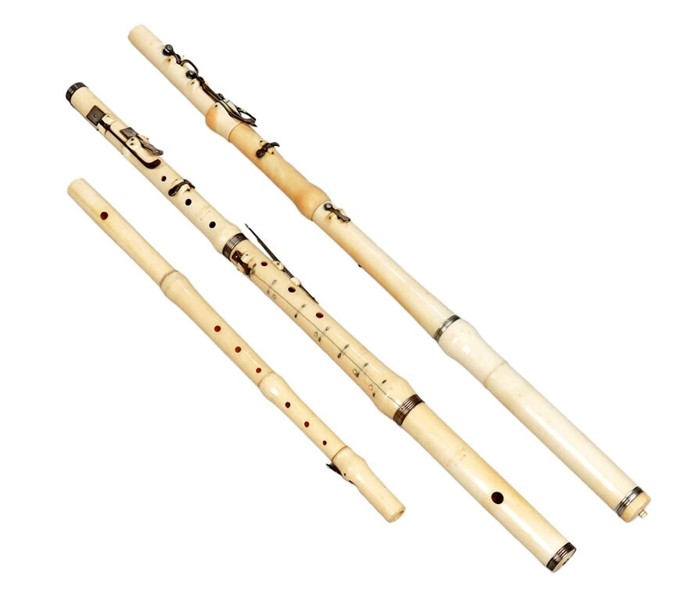
If you are a bit hazy about which woodwind instrument is which, you can’t really mistake the flute because in the orchestra it’s the only woodwind instrument that is played sideways. The same goes for the other members of the flute family which includes the piccolo (the Italian name simply means “small”) and the larger and less often seen alto flute. You might be surprised to know that there is even a contrabass flute, a massive unwieldy contraption which is sometimes heard in flute ensembles. It makes a strange and ghostly sound and gives some people the creeps.
Unlike other woodwind instruments which use a reed to produce the vibrating air, the flute sound is created by blowing across the top of a hole at the end (or head-joint) of the instrument in much the same way as children produce an owl-like sound by blowing across the top of an empty bottle. Flutes, in one form or another have been around for thousands of years. One of the earliest examples was discovered recently in Germany: a simple five-holed flute made from the wing bone of a vulture and shown to be 35,000 years old. Some other ancient flutes found in Europe are thought to be much older, possibly 43,000 years. Of course, flute-type instruments are known in different cultures all over the world and especially in Asia.
Traditionally, flutes were made of bone, bamboo or wood but today, despite being classed as a woodwind instrument, most flutes are made of metal. The exception is the piccolo which is usually still made of wood. Student flutes are made of nickel, silver, or brass that has been silver-plated, while many professional players prefer flutes made of solid silver or gold. Some top professional players use instruments use flutes made of platinum but they don’t come cheap. And for that matter, neither do the players. Incidentally, in America, flute players are referred to as “flutists” which seems logical, but in Britain they are known as “flautists”.
During the Baroque, recorders were generally used in ensembles but gradually they were replaced by flutes which had a brighter and more penetrating tone quality. Even by the end of the 18th century it was still a relatively simple instrument for the complex Boehm system of mechanical key-work had yet to be invented.
Although Mozart evidently disliked the flute he wrote a concerto for it, commissioned by the well-known Dutch flute player Ferdinand De Jean. For generations, it was thought that Mozart wrote two flute concertos, but in the 1950s evidence came to light that the second concerto was actually a reworking of his own oboe concerto. The first concerto dates from 1778 and its cast in the usual three movements. It receives a lively performance by these fine Korean musicians and as a bonus the encore piece is Paganini’s Caprice No 24, originally written for solo violin in 1807 and considered by musicians to be one of the most difficult violin pieces ever written. This work, you may notice is the one with the famous opening theme which was since borrowed by dozens of other composers as a basis for orchestral variations.
In the late eighteenth century, Mannheim had the finest and most famous court orchestra anywhere. It attracted some of Europe’s best instrumental players and composers and was lavishly funded by Duke Karl Theodor. The composer Carl Stamitz is closely associated with the Mannheim School and his father Johann is considered to be its founder. By the age of seventeen Carl Stamitz was employed as a violinist in the Mannheim court orchestra and his father must have had hopes for him. However, at the age of twenty-five, Carl left his secure job in Mannheim and began concert tours around Europe. For a time he lived in London. He was a prolific composer, turning out more than fifty symphonies, sixty concertos and a large amount of chamber music.
The concertos are noted for melodic appeal and courtly grace rather than virtuosity. Despite his musical achievements Stamitz was less successful at managing his finances. He never managed to hold down a job with one of the major royal courts. It seems that he taught at the university at Jena, but received only a modest income. He began to sink into debt and inevitably his funds ran dry. Then in January 1801, his wife died. By the following November, Stamitz too was in his grave. All his possessions, including many tracts on alchemy were auctioned to pay off his debts. Whether Stamitz was studying alchemy to try and turn base metals into gold, cure some disease or search for the elixir of youth we simply don’t know.
To watch these YouTube videos, either use your Smartphone to read the QR codes or go to this article online, click on the “live” links and go direct to the videos. If you have a laptop, sound quality can be improved significantly by using headphones or external speakers.
 |
 |
 |





